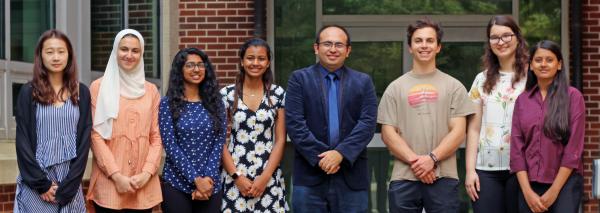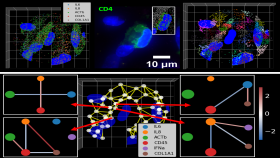Ahmet Coskun has seen the future for the ubiquitous poster session and it is paperless. Coskun, assistant professor in the Wallace H. Coulter Department of Biomedical Engineering (BME) at Georgia Tech and Emory University, instead envisions a more vibrant way to present research to participants at scientific conferences and other gatherings.
“Paper posters fail to explain the dynamic properties of our imaging data, so we cannot adequately connect our research with the audience,” says Coskun, who is also a researcher in the Petit Institute for Bioengineering and Bioscience at Tech, where he directs the Single Cell Biotechnology Laboratory. There, an interdisciplinary team of researchers interested in photons, ions, and electrons (and their interactions with cells) combines large-scale experiments and computational analysis to address fundamental challenges in infections, cancers, and immunology to create image-based technologies to reveal the spatial nature of biological systems.
To help address the issue of adequate representation of a biological system’s dynamic properties, Coskun earlier this year launched the Bioengineering (BioE) Media Lab at BME, an interactive studio lab designed to integrate emerging digital technologies with cellular imaging and analysis tools for unconventional scientific explorations and innovative educational teaching platforms. It’s through the BioE Media Lab that Coskun and graduate researcher Mythreye Venkatesan have introduced their new concept for digital research posters. They write all about it in a in a recently published paper in Communications Biology (an open-access journal from Nature Research publishing).
In a sense, Coskun and Venkatesan are like artists trying to develop the best medium to convey their vision. In this case, that vision involves images at the cellular scale, a changing biological landscape that doesn’t translate effectively to static pictures and graphs. So, taking a cue from the art community, they’ve employed multiplexed imaging for movies of cells as a demonstration of their digital poster idea, which provides, “an interactive and low-cost tool for next-generation sharing platforms,” they write.
“We found that there is a crucial need for innovation that bridges the gap between old-fashioned poster presentations and current visual technologies,” says Coskun.
In their report, entitled, “Digital posters for interactive cellular media and bioengineering education,” the team presents a solution that they believe could be a transformative interactive tool in research fields that utilize complex molecular, cellular, organ-level, or structural media.
The team uses a digital art frame developed by American technology company Meural, which developed a platform that enables the upload of digital art galleries via a wireless network. Coskun says the widely-available technology was the perfect canvas on which to design digital research posters.
“The nice thing is, you can easily update the poster using a smartphone or computer app,” Coskun says. “We update our research every month, easily. We get new results and new discoveries of how cells are behaving. The digital poster concept allows a dynamic presentation that we can change as our results change.”
In the paper they also offer insight into future generations of digital posters, which will feature folding displays controlled by touchscreen and motion controls. Their idea would involve lightweight (i.e., easy to transport) interactive displays that unfold to poster size. They also envision digital technologies being deployed as instructional platforms, writing, “virtual reality offers training opportunities for students and researchers in engineering and medicine. Digital posters, therefore, have great potential for bioengineering education that generates cellular and medical imaging datasets.”
In addition to the technological, functional, and educational potential for digital posters, Coskun and Venkatesan also offer economic argument in support of the new paradigm.
“On average, a paper poster will cost $100, and in a month or two, you need another one. The costs really add up,” Coskun says. “There’s an initial cost with the digital posters of about $500. But, as long as our hardware and software are compatible and stays current with state of the art visual technology, that poster will be very useable.”
Media Contact
Jerry Grillo
Communications Officer II
Parker H. Petit Institute for
Bioengineering and Bioscience
Keywords
Latest BME News
Commercialization program in Coulter BME announces project teams who will receive support to get their research to market.
Courses in the Wallace H. Coulter Department of Biomedical Engineering are being reformatted to incorporate AI and machine learning so students are prepared for a data-driven biotech sector.
Influenced by her mother's journey in engineering, Sriya Surapaneni hopes to inspire other young women in the field.
Coulter BME Professor Earns Tenure, Eyes Future of Innovation in Health and Medicine
The grant will fund the development of cutting-edge technology that could detect colorectal cancer through a simple breath test
The surgical support device landed Coulter BME its 4th consecutive win for the College of Engineering competition.
New research from Georgia Tech helps doctors predict how therapies will interact with a child's immune system, potentially improving outcomes and reducing risks.









